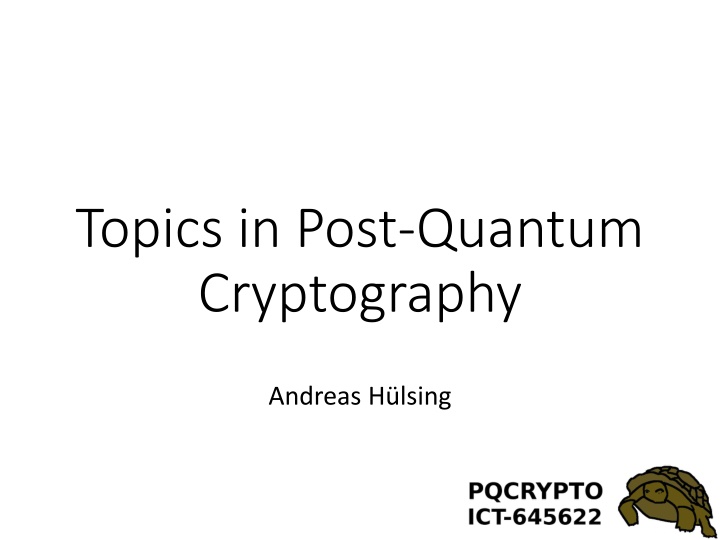
Exploring Post-Quantum Cryptography and Quantum Security
Delve into the latest developments in post-quantum cryptography, including state-of-the-art standards, NIST competitions, and advancements in quantum security. Learn about Shor's algorithm, Grover's algorithm, and the ongoing efforts to ensure the security of cryptographic systems in the quantum computing era.
Download Presentation

Please find below an Image/Link to download the presentation.
The content on the website is provided AS IS for your information and personal use only. It may not be sold, licensed, or shared on other websites without obtaining consent from the author. If you encounter any issues during the download, it is possible that the publisher has removed the file from their server.
You are allowed to download the files provided on this website for personal or commercial use, subject to the condition that they are used lawfully. All files are the property of their respective owners.
The content on the website is provided AS IS for your information and personal use only. It may not be sold, licensed, or shared on other websites without obtaining consent from the author.
E N D
Presentation Transcript
Topics in Post-Quantum Cryptography Andreas H lsing
State of affairs Standards track Stateful hash-based signatures: XMSS, LMS (Internet drafts) NTRUEncrypt (IEEE Std 1363.1, X9.98) Hundreds of proposed schemes
Official developments Feb `13: First PQC draft in IRTF s CFRG Sep `13: ETSI holds first PQC WS (afterwards annually) April `15: NIST holds conference on PQC Aug `15: NSA announces transition to PQC Feb `16: NIST announces `PQC competition Dec `16: NIST opens call for proposals Scheduled: Nov `17: NIST submission deadline 2024: Draft standards ready (NIST, Feb `16)
NIST Competition SPHINCS Selection of Digital signature and Public key encryption / Key exchange Probably > 100 submissions No single winner Classically this will spark interest in cryptanalysis
Shors algorithm (1994) Quantum computers can do FFT very efficiently Can be used to find period of a function This can be exploited to factor efficiently (RSA) Shor also shows how to solve discrete log efficiently (DSA, DH, ECDSA, ECDH)
Grovers algorithm (1996) Quantum computers can search ? entry DB in ( ?) Application to symmetric crypto Nice: Grover is provably optimal (For random function) Double security parameter.
(Quantum) security Are attacks using Grover efficient? Is Grover speed-up the only thing we can get ? Currently working to prove this for hash functions (under certain assumptions) Are the PQ problems classically secure? What is the exact security? We never had provably secure crypto Can we classically break RSA? Who knows!
Results Sponges are quantum collision-resistant if block function is random function or random one-way permutation (does not cover SHA3!) 12
Why not beat em with their own weapons? QKD: Quantum Key distribution. Based on some nice quantum properties: entanglement & collapsing measurments Information theoretic security (at least in theory) -> Great! For sale today! So why don t we use this? Only short distance, point-to-point connections! Internet? No way! Longer distances require trusted-repeaters We all know where this leads...
Side-channels Implementations might leak secret information through timing, cache-access patterns, electro-magnetic radiation, power consumption... Not covered by standard security models. 16
Implementation security Still hard for traditional schemes New PQ Problems come with new basic operations Not much research yet (for PQC) But a lot of experience
Discrete Gaussians Basic building block in lattice-based cryptography. Used to hide secret. Unknown how to implement efficiently in constant time. 18
Results Attack on BLISS [DDLL 13], implemented in StrongSwan library. Practical cache attack on both implemented samplers. First algorithm to un-hide secret key given side- channel information for Gaussian noise. Can compute secret key after < 5000 signatures. Ongoing: Solution: Allow for constant-time sampler by changing the distribution. 19
Signatures (Source https://ia.cr/2017/279)
Integration Smaller but less conservative signature choices exist PKE / KEX: Sizes better Can your protocol fit a 40KB public key / signature? How to deal with immaturity of PQ Problems? Combiners -> pay in size / speed
Conclusion A lot of important questions ahead Strengthen confidence Secure implementations All solvable but need time & money Might have to rethink existing protocols Will not get MUCH smaller
Thank you! Questions? 18-3-2025 PAGE 24
